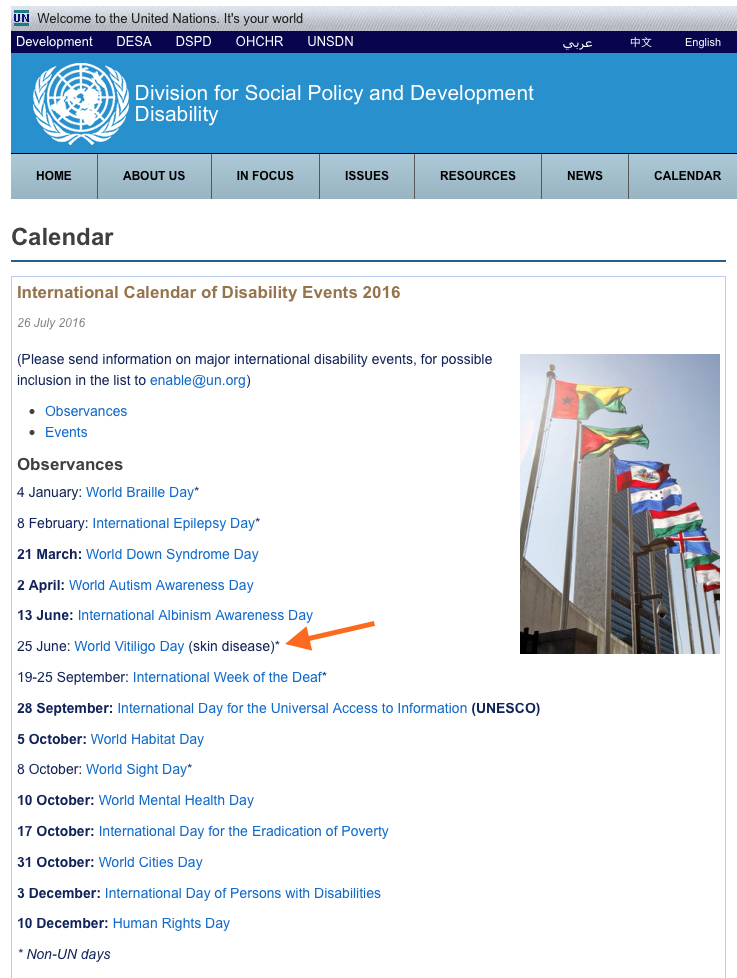New
World Vitiligo Day Marks UN Calendar!
World Vitiligo Day, celebrated on June 25th, is an annual event that aims to raise awareness about vitiligo, a skin condition that affects millions of people worldwide. This year, the United Nations included World Vitiligo Day on its official calendar of disabilities, recognizing the importance of the day and the need to address the challenges faced by people living with vitiligo.
Vitiligo is a skin condition that causes loss of pigmentation, resulting in white patches on the skin. It affects people of all races and ages, and while it is not a life-threatening condition, it can have a significant impact on a person's self-esteem and quality of life. Unfortunately, there is still a lot of stigma associated with vitiligo, and many people living with the condition feel isolated and ashamed.
The inclusion of World Vitiligo Day on the UN Calendar of Disabilities is a significant step towards raising awareness about the condition and breaking down the stigma associated with it. By recognizing vitiligo as a disability, the UN is sending a message that people living with the condition deserve to be treated with respect and dignity, and that their needs must be taken into account.
Prof. Jana Hercogova, the Chair of WVD 2016 campaign, held a key media event in beautiful Prague. Celebrations continued the whole weekend with a series of events held in Washington DC on June 24-25. This idea came alive after a successful rally at the Massachusetts State House organized by VITFriends from Boston last year. Nobody could expect that the number of participants would grow exponentially. This year, Valerie Molyneaux led a 300-plus rally, representing an array of activists, nonprofits, researchers, healthcare workers, politicians, and elected officials.
The events held across the world were aimed at raising awareness about vitiligo and promoting a positive image of people living with the condition. World Vitiligo Day provides an opportunity to educate the public, healthcare professionals, and policymakers about the impact of vitiligo on individuals and society as a whole. Through this day, people can learn about the symptoms, treatment options, and ongoing research efforts to find a cure for vitiligo.
On this World Vitiligo Day, we must continue to raise awareness about the condition and work towards breaking down the stigma associated with it. We must also support those living with vitiligo by providing access to resources and support networks that can help them manage their condition and improve their quality of life.
Together, we can make a difference and ensure that people living with vitiligo are treated with the respect and dignity they deserve.

FAQOther Questions
- Which is better for judging vitiligo — Wood’s lamp or dermoscopy?
A recent study out of India compared the two head-to-head. Both tools correlated fairly well with clinical criteria, but dermoscopy had a slight edge: Wood’s lamp: sensitivit...
- Белые пятна на теле? Витилиго?
Гид по Витилиго — ваш компас в лабиринте загадочной болезни и непростых решений. Здесь всё по-честному, по делу и на понятном языке. Вы найдёте здесь: Объяснения, что прои...
- Who is prone to vitiligo?
Vitiligo can affect anyone, regardless of gender, age, or race. Vitiligo prevalence is between 0.76% and 1.11% of the U.S. population, including around 40% of those with the con...
Though it is not always easy to treat vitiligo, there is much to be gained by clearly understanding the diagnosis, the future implications, treatment options and their outcomes.
Many people deal with vitiligo while remaining in the public eye, maintaining a positive outlook, and having a successful career.
Copyright (C) Bodolóczki JúliaBy taking a little time to fill in the anonymous questionnaire, you can help researchers better understand and fight vitiligo.
